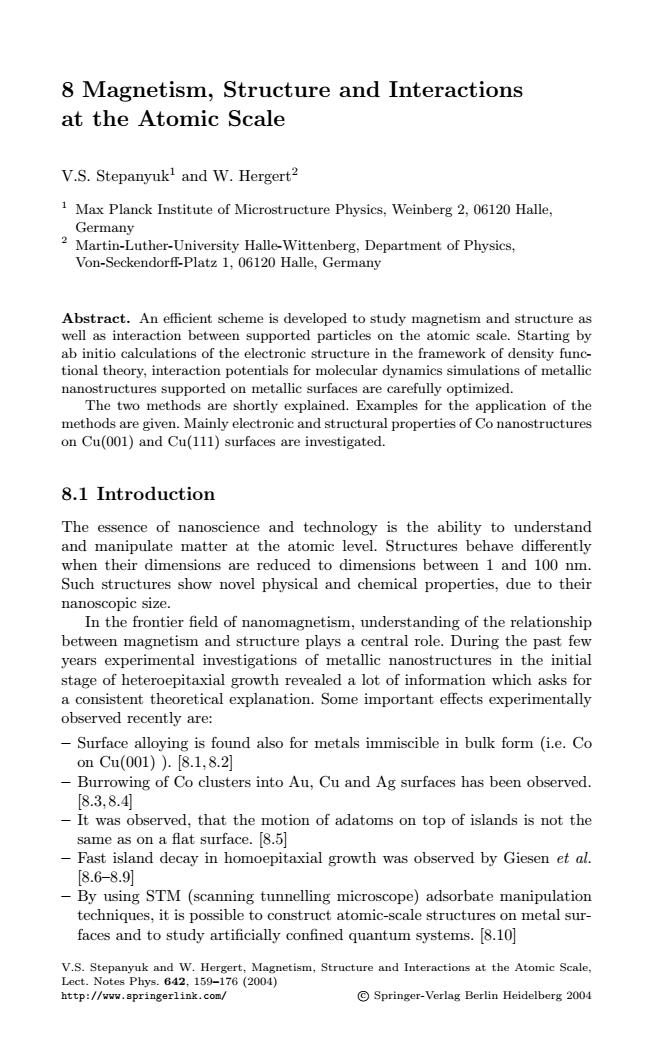正在加载图片...

8 Magnetism,Structure and Interactions at the Atomic Scale V.S.Stepanyuk!and W.Hergert2 1 Max Planck Institute of Microstructure Physics,Weinberg 2,06120 Halle, Germany 2 Martin-Luther-University Halle-Wittenberg,Department of Physics, Von-Seckendorff-Platz 1,06120 Halle,Germany Abstract.An efficient scheme is developed to study magnetism and structure as well as interaction between supported particles on the atomic scale.Starting by ab initio calculations of the electronic structure in the framework of density func- tional theory,interaction potentials for molecular dynamics simulations of metallic nanostructures supported on metallic surfaces are carefully optimized. The two methods are shortly explained.Examples for the application of the methods are given.Mainly electronic and structural properties of Co nanostructures on Cu(001)and Cu(111)surfaces are investigated. 8.1 Introduction The essence of nanoscience and technology is the ability to understand and manipulate matter at the atomic level.Structures behave differently when their dimensions are reduced to dimensions between 1 and 100 nm. Such structures show novel physical and chemical properties,due to their nanoscopic size. In the frontier field of nanomagnetism,understanding of the relationship between magnetism and structure plays a central role.During the past few years experimental investigations of metallic nanostructures in the initial stage of heteroepitaxial growth revealed a lot of information which asks for a consistent theoretical explanation.Some important effects experimentally observed recently are: Surface alloying is found also for metals immiscible in bulk form (i.e.Co onCu(001)).[8.1,8.2 Burrowing of Co clusters into Au,Cu and Ag surfaces has been observed. [8.3.8.4 It was observed,that the motion of adatoms on top of islands is not the same as on a fat surface.[8.5 Fast island decay in homoepitaxial growth was observed by Giesen et al. [8.6-8.9] By using STM(scanning tunnelling microscope)adsorbate manipulation techniques,it is possible to construct atomic-scale structures on metal sur- faces and to study artificially confined quantum systems.[8.10] V.S.Stepanyuk and W.Hergert,Magnetism,Structure and Interactions at the Atomic Scale, Lect.Notes Phys.642,159-176(2004) http://www.springerlink.com/ C Springer-Verlag Berlin Heidelberg 20048 Magnetism, Structure and Interactions at the Atomic Scale V.S. Stepanyuk1 and W. Hergert2 1 Max Planck Institute of Microstructure Physics, Weinberg 2, 06120 Halle, Germany 2 Martin-Luther-University Halle-Wittenberg, Department of Physics, Von-Seckendorff-Platz 1, 06120 Halle, Germany Abstract. An efficient scheme is developed to study magnetism and structure as well as interaction between supported particles on the atomic scale. Starting by ab initio calculations of the electronic structure in the framework of density functional theory, interaction potentials for molecular dynamics simulations of metallic nanostructures supported on metallic surfaces are carefully optimized. The two methods are shortly explained. Examples for the application of the methods are given. Mainly electronic and structural properties of Co nanostructures on Cu(001) and Cu(111) surfaces are investigated. 8.1 Introduction The essence of nanoscience and technology is the ability to understand and manipulate matter at the atomic level. Structures behave differently when their dimensions are reduced to dimensions between 1 and 100 nm. Such structures show novel physical and chemical properties, due to their nanoscopic size. In the frontier field of nanomagnetism, understanding of the relationship between magnetism and structure plays a central role. During the past few years experimental investigations of metallic nanostructures in the initial stage of heteroepitaxial growth revealed a lot of information which asks for a consistent theoretical explanation. Some important effects experimentally observed recently are: – Surface alloying is found also for metals immiscible in bulk form (i.e. Co on Cu(001) ). [8.1, 8.2] – Burrowing of Co clusters into Au, Cu and Ag surfaces has been observed. [8.3, 8.4] – It was observed, that the motion of adatoms on top of islands is not the same as on a flat surface. [8.5] – Fast island decay in homoepitaxial growth was observed by Giesen et al. [8.6–8.9] – By using STM (scanning tunnelling microscope) adsorbate manipulation techniques, it is possible to construct atomic-scale structures on metal surfaces and to study artificially confined quantum systems. [8.10] V.S. Stepanyuk and W. Hergert, Magnetism, Structure and Interactions at the Atomic Scale, Lect. Notes Phys. 642, 159–176 (2004) http://www.springerlink.com/ c Springer-Verlag Berlin Heidelberg 2004